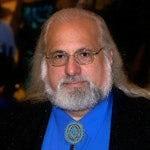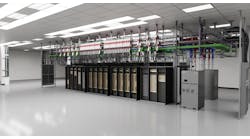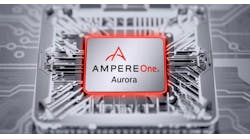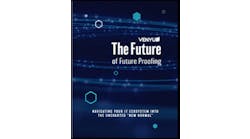Eaton's Data Center Vision Conference Focuses On Power Demands, Design Innovation
Speaking to customers, partners, and employees at Eaton's 2024 Data Center Vision conference (Apr. 22-24) in Orland0, Florida, Molly Murphy, Eaton's Senior Vice President of North American Sales, made it clear that the way that the data enter market is changing requires innovative solutions from both business and industry.
Emphasizing Eaton’s broad portfolio of power management solutions while addressing issues of both hardware and software, Murphy spoke of the focus on innovation and problem solving that the company’s solutions provide.
Addressing the rapid changes in power demand in the market, she further talked about the importance of innovation in all segments of the power industry, from utility to customer; and the changes that will be needed to address the market demand, especially to deal with increased demand for power and density in the data center space.
Power Management and Addressing the Power Demands of AI
Sitting down with Jason Anderson, Eaton's Director of Marketing, Critical Power Solutions and Keven Landis, the company's Director of Marketing, Power Distribution Controls and Assemblies, gave us a chance to focus on what they were seeing in terms of customer demand and how Eaton is addressing key customer needs.
Unsurprisingly, Anderson and Landis said that power management for data center workloads and the changes that the power demands of AI were placing on infrastructure are top concerns.
They noted that for many years in the cloud era, utilities were used to seeing flat, steady loads from their data center customers; but with the addition of AI processing, the traditional modeling for power is not as applicable.
AI processing powered by GPUs is different than the traditional data center that was CPU-driven, and the power management needs to take that in to account and address the differences. This is one of the reasons for the industry's increased interest in energy storage solutions and microgrids.
Landis noted, “We have a microgrid controller and we also work with other vendors, as well. The goal is to help customers mange the power between all different utility sources. In the demand response model, when there are those peaks and valleys, site power generation can be sold back to the utility, if necessary, in a bi-directional model.”
Landis continued, “Remember when switch gear didn't do anything but open and close breakers manually? Now switch gear is embedded with solid state trip units, solid state relays, metering devices, the ability to control and transfer loads; and then the ability to take all of that and connect to the utility with a smart system that goes all the way from the utility to the data center to help manage the power.”
In terms of power management, Anderson told us that Eaton is leading the way on the energy transition of the UPS; it’s not just a backup device anymore, but the core of an energy storage system that enables the data center to meet the demands of rapidly changing energy requirements.
Anderson added, “For the power distribution piece of it, I think AI is going to drive a whole new set of opportunities. The power density at the rack is going to go through the roof and it's going to cause a tsunami effect through the power chain, in terms of: how things were done in past, may not be how things are done in the future.”
Anderson pointed to Eaton’s experience in industries other than data centers, saying he believes that having worked in a broad range of industrial environments and industries that have changed the way that they deal with power ideally positions the company to react to these changes in the way that data centers must deal with power demands, now and in the future.
The Changing Relationship from the Utility to the Data Center Rack
For a slightly different perspective on the customer relationship, we spoke with Aidan Graham, Eaton's Senior Vice President and General Manager, Critical Power Solutions; and Raul Cadalzo, the company's Vice President of Data Center Sales.
Graham’s people are in the trenches; he is responsible for the service business that puts repair trucks on-site to keep customerss systems up and running.
“When something goes down in the mission critical side of the data center, the customer wants us there and they want their systems back up when we leave,” noted Graham.
The service business deals in maintaining the SLAs for which the customer has contracted; using what is referred to as “van stock,” or the parts that the repair vans routinely carry, Graham said the company's first-visit repair rate exceeds 75%.
Cadalzo, as Vice President of Sales for Eaton's data center verticals, has an excellent overview of how the entire Eaton product line under Graham's direction applies to the data center industry.
“Starting with the incoming power that comes from a utility and goes to the substation, to a data center campus, all the way down to right at the rack, from power distribution to power conversion, it incorporates transformers, medium voltage switchgear, low voltage switchgear, and busways,” said Cadalzo.
As Eaton deals with data center the environment from the substation to the rack, to fully support this, the company's services business headed up by Graham is augmented by a business unit focused on power distribution, and an engineering services unit that does all of the start-up commissioning for supplied power distribution equipment.
So What’s Driving the Customer Now?
"There is obviously there's a lot going on in the data center market these days, in terms of the evolution of AI, which is driving, I'll say, two types of demand,” said Cadalzo. “There are those customers that are already using AI applications or getting ready to deploy them. And then there are those customers that either aren't as heavily invested, or perhaps have moved some of their applications into the cloud.”
Eaton has seen an acceleration of movement to the cloud, and is seeing demand that's being driven by AI applications, as well as other applications that are moving in preparation to support greater cloud use.
”The AI piece is driving higher power density at the rack, and a pretty direct correlation to our ability to serve and grow our business,” explained Cadalzo.
Graham added, “We talk a ton about the data center of the future, and making sure that we're not so focused on the designs of today that we're missing out on new technologies that we need."
He continued:
"When racks go from 30 kW to 100 kW, it doesn't just impact the rack. It impacts everything back to the utility interconnect point. And we want to make sure we're there. We offer products and services all the way from the rack all the way to the grid. We want to make sure we're there with the right stuff and the right amount of product, service, and support.
So it's kind of a two part story that we're talking about. It’s what are we doing to increase demand to hit the needs of today, and what are we going to do to partner with customers and launch new offerings to hit the demands of the data center of the future - because it's not going to look the same.”
In many ways, this comment summarizes much of the discussion and presentations we heard at Eaton's event.
The landscape of the data center market is changing, and to meet this challenge, Eaton is leveraging their historical knowledge of the industry, their experience in other industries, and an understanding that they need to partner with their customers to maintain high operational levels now, while being ready for whatever changes the future will bring.
We heard the same, consistent message from the top down: That focused innovation that directly addresses customer needs will be the driving force for Eaton's future in the data center.






